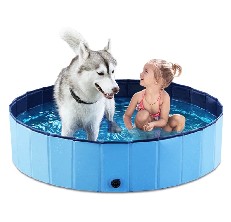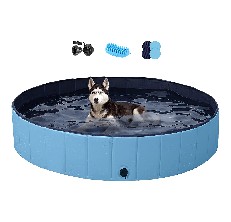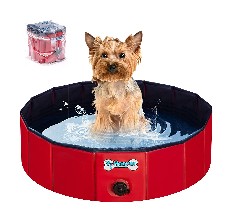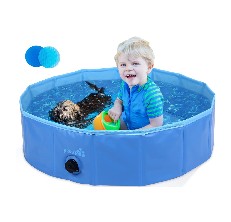- Home
- Gear Categories

Last updated: 8 Mar 2024
We independently research, test, review, and recommend the best products - learn more about our process here. If you buy something through our links, we may earn a commission.
The Best Dog Pool For All Your Pup’s Summer Fun
Published 2 Dec 2020
Show contents
Here are some optimal dog pools of 2024
One of the best ways to keep our fur babies safe and cool while outdoors is with an easily accessible doggie pool. These versatile and durable pools resemble kiddie pools but are made to handle the wear and tear of active and energetic dogs. They provide a safe and reliable way to help your pooch cool down and relax while outside. Also, your kids would love to join the dogs during these fun pool sessions, so finding an easy-to-clean option for a dog pool is essential as you’d want to clean up the pool before using it every time to ensure it does not contain any harmful germs. Some of the best dog pools in 2024 have been selected and highlighted here for your consideration, so be sure to check them out and find one to keep your pup cool and relaxed.
Here are some optimal dog pools of 2024
1
Jasonwell Foldable Dog Pool
– Best OverallTHE SCOOP
This portable dog pool provides a quick and easy way to help your dog keep cool and stay comfortable while causing you minimal inconvenience. It is durable and easy to use in hot weather. Also, as the pool is completely foldable, you can take it on trips as well to provide your dog a healthy activity anytime, anywhere.
Pros
- Durable material of this dog pool holds up to sharp claws
- Collapsible design makes the pool easy to move and store
- Overall size allows for enough water to stay cool without it being too deep
- Several sizes are available to choose from
Cons
- The pool must be moved often to avoid killing grass in the yard
2
Yaheetech Foldable Swimming Pool For Dogs
– Runner-UpTHE SCOOP
This foldable and portable doggie pool is designed for quick and easy use. With a variety of sizes to choose from and a versatile overall design, this pool is great for people and dogs alike, so you and your kids can jump in the pool with your dogs to have some high-quality family time.
Pros
- Textured bottom and sizes of this pool prevent slipping and sliding
- Durable material holds up to frequent use
- Pool is designed for medium to larger breeds
- Easy drain port allows for quick emptying and relocating
Cons
- The pool can be cumbersome to set up at times
3
V-Hanver Pet Bath Tub
– Honorable MentionTHE SCOOP
With several usable sizes to choose from and an overall design that is made to handle regular playtime, this pool is a great choice for any pet owner who wants to keep their dog cool and comfortable.
Pros
- Dog pool sizes are available for small to large breeds
- Thick base and sides hold up to regular use and play
- Easy drain spout makes moving the pool a snap
- Padded exterior walls keep your pooch safe while they play
Cons
- The pool can be a bit heavy and difficult to move alone
4
Pecute Dog Pool
– Also ConsiderTHE SCOOP
This dog pool is perfect for smaller breeds. It is easy to set up and use while also providing a safe place for your pup to cool down. It can be kept shallow for laying in or filled deeper for some swimming fun.
Pros
- Lightweight design is easy to fold and transport
- Several pool sizes are available to choose from
- Textured bottom reduces slipping
- Light-colored material reduces heat absorption in the sun
Cons
- Thinner material can be easily damaged by claws
Buyer's Guide to Finding Your Pup's Favorite Dog Pool
If you want to boost your dog’s morale and overall attitude towards you as the owner, you should do more than pet them. Feeding them is a given, but giving them a fun-filled engaging activity is another way to treat them just like family. And what better way to do it than giving them their own swimming pool.
If humans, especially kids, enjoy playing in the water, dogs are not any different. Not all dogs like to take a shower, but dipping in a pool is something almost every dog enjoys.
Why Your Dog Needs A Pool
Dogs love to play, and if you are a dog owner, you probably bought your dog a toy to play with already. But, if you want to become dog parent of the year, then it is time to make a grander gesture and get them a dog pool.
There is more than one reason for getting your dog a pool. Yes, it is amusing to play once in a while, but there are way more benefits than that. Swimming can be an excellent way to exercise, it can stimulate their brain, and it is a perfect way for them to stay cool during the summer. Anyway, here are some of the benefits of having a dog pool for your four-legged buddy to enjoy.
Dog Pool Benefits
Relaxation
Aside from fun, dipping and getting wet in a pool is a great way to relax. It can keep your dog calm if they feel any stress—which they really shouldn’t feel under your care. Anyhow, if you want your dog to have happier days, getting them a pool is one way to make that happen.
Training
Swimming in a pool is a great way to train your dog to enjoy the water—meaning your dog will enjoy showering more resulting in no more awful dog smell inside your home. Some people have a hard time cleaning up after their furry friends, and we don’t blame you. Some dogs just don’t like to shower. But most of them like swimming, and you can trick them into showering by using a dog pool as a bathtub for your dog. Your dog would barely even notice!
Mental Stimulation
Swimming can be mentally stimulating for your dog. Unlike humans, dogs do not have many activities, and sometimes they can get really bored. Swimming in a dog pool can stimulate their brains. It is a great activity that can make them happier and more positive overall.
Great For Fighting Against The Heat
If you feel very hot and irritated during 100-degree days, imagine how dogs would feel. Allowing them to swim during scorching hot days helps them beat the heat. Plus, wet fur helps them stay cool for longer, or at least until it dries up—providing them with the relief that your cute furry babies deserve.
Great Way To Exercise
Lastly, swimming is an excellent way for dogs to get some exercise. In addition to their much-beloved walks, swimming offers another great way for dogs to get some cardio, helping them stay healthier and have potentially longer lives.
How To Choose The Best Dog Pool For Your Furry Friend
Size Of Your Dog
Choosing the size of the pool depends on the size of your pup. Make sure it is big enough so that they can move and play around comfortably.
Pool Type
There are several dog pool types, and you can choose one based on the space in your backyard or your storage options.
Rigid pools are more like kiddie pools, and they are made with solid materials that are more likely to last longer.
Inflatable pools are excellent options that you can inflate and deflate anywhere. They are much more portable and easier to store, but they are not as durable as your other options.
Folding pools offer the best combination of portability and durability. They are sturdier than inflatable pools and more portable than rigid pools. This type is a great option if you are looking for something easier to store and something that can last longer.
Dog Pool Safety Tips
Keep An Eye On Your Pet
Make sure you don’t leave your dog by itself while in the pool, especially if they don’t have much swimming experience.
Avoid Swimming When It’s Cold
Swimming during cold days may cause your dog to get sick. Make sure you don’t allow your dog to swim for a long time, and dry them up immediately after.
Clean And Maintain The Pool Regularly
Whether the type of dog pool you own, it would be ideal if you clean it regularly. Dogs love to wander and get dirty, which means the pool can get riddled with germs and bacteria. So, make sure you keep the pool clean before using it again.
Use A Ramp For Larger Pools
For larger pools, having a dog ramp will allow your dog to get out whenever they want, safely.
Use Sunscreen
Use sunscreen on your dog when swimming in the summers, especially if your dog has short and thin fur. Being under the sun for so long may not be too good for your dog’s skin.
Dog Pool Accessories To Consider
Getting a dog pool is the first step, but adding a few accessories can really breathe life into the whole swimming activity. Consider adding the following dog pool accessories to your dog pool.
- Dog floating toys
- Dog escape ramps
- Dog pool floats
- Swimming vest and dog life jacket
People Also Asked
Q: CAN CATS SWIM IN DOG POOLS?
A: Unlike dogs, cats are not really good swimmers. If you want to provide a swimming space for your cat, make sure the pool is not too deep as they can easily drown.
Q: CAN DOGS SWIM?
A: Not all dogs can swim but, just like humans, dogs can learn how to swim based on their survival instincts. But make sure you keep an eye on them, especially if they are not wearing a life jacket.
Q: CAN KIDS USE DOG POOLS?
A: Yes, dog pools are the perfect size for some kids to dip in. However, make sure the water is clean before allowing your kids to swim in a dog pool. Alternatively, there are also kiddie pools that are safer for both kids and dogs to use.
Contributors
Former Special Forces Canine Handler



